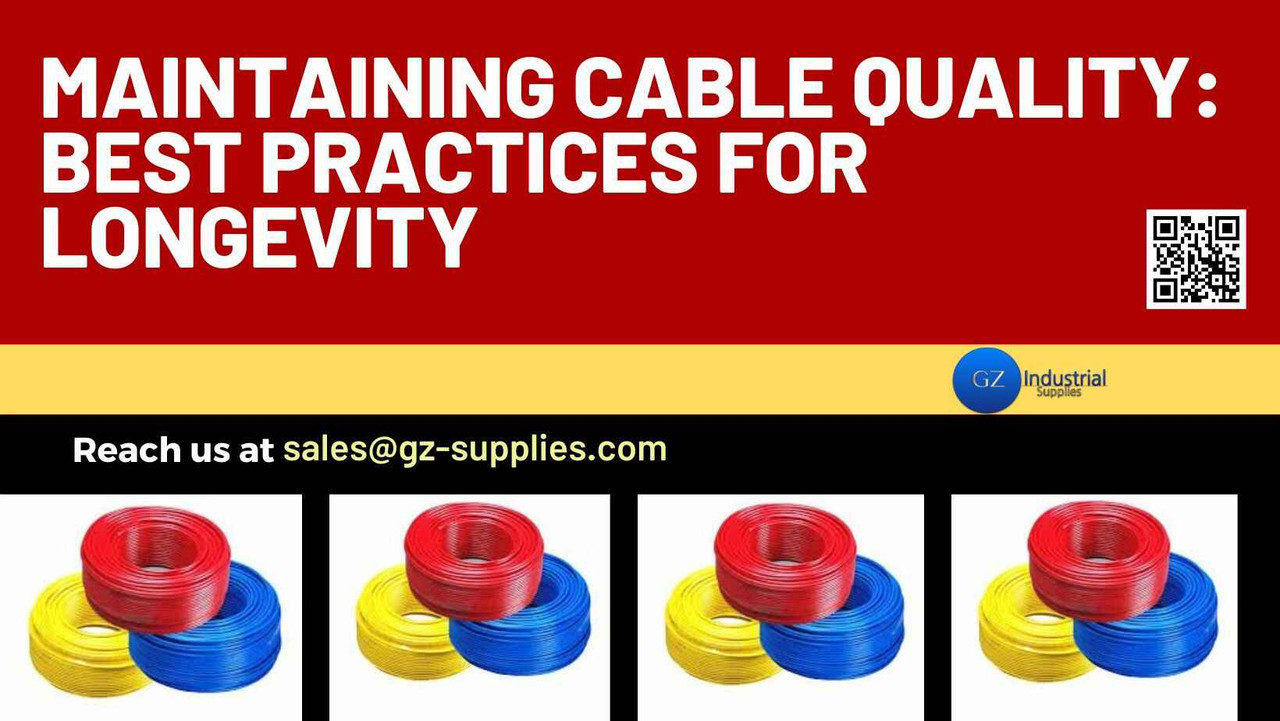Maintaining Cable Quality: Best Practices for Longevity
Key Takeaway
- Regular Inspection: Perform routine checks to identify wear, fraying, or damage to cables, preventing potential failures and hazards.
- Proper Storage: Store cables in cool, dry environments away from direct sunlight, moisture, or chemicals to preserve insulation and conductivity.
- Avoid Overloading: Ensure cables are used within their rated voltage and current capacity to prevent overheating and degradation.
- Handle with Care: Avoid bending, twisting, or pulling cables excessively to prevent internal damage and maintain performance.
Introduction
Cables are the unsung heroes of our modern world. From powering our devices to facilitating data transfer and enabling communication, cables are essential to the operation of nearly every electronic system we use. However, despite their importance, cables are often overlooked when it comes to maintenance. Poor cable quality or degradation can lead to significant performance issues, such as slower data speeds, power loss, or even complete system failure. This makes maintaining cable quality a critical aspect of technology upkeep.
The goal of this guide is to provide practical tips and insights on how to prolong the life and maintain the quality of your cables, ensuring that they continue to perform at their best for as long as possible. By following these best practices, you can avoid costly replacements and prevent issues that might arise from faulty or damaged cables. Whether you use cables for home electronics, industrial machines, or networking purposes, these maintenance strategies are universally applicable.
Cutix Electrical Cable 6mm Single Core
Understanding Cable Types and Construction
Common Types of Cables
There are many different types of cables, each designed for specific functions. Understanding the differences can help you determine the most appropriate care for each type.
1. Power Cables: These cables deliver electrical power from a source to your devices, such as appliances, computers, or industrial machines. They are usually made of copper or aluminum conductors, covered by insulation material for protection.
2. Network Cables: Ethernet cables, fiber optics, and other network cables are designed for data transmission. They are often subjected to high-speed data demands and are more susceptible to signal degradation when not maintained properly.
3. Audio/Video Cables: HDMI, coaxial, and RCA cables are typically used to transmit audio and video signals. Poorly maintained audio/video cables can result in pixelated images or distorted sound.
4. USB and Charging Cables: Commonly used for transferring data and charging electronic devices, USB cables are often flexible and can wear down quickly if not cared for properly.
Cable Construction Basics
A cable is made up of several key components, each playing a role in ensuring its functionality and durability. Here’s a breakdown of the essential parts:
1. Conductors: Typically made of copper or sometimes aluminum, these are the parts of the cable that carry electrical signals or current.
2. Insulation: The insulating layer surrounding the conductor prevents electrical short circuits and protects users from electrical shock.
3. Shielding: Shielding is used to protect the cable from external interference and to prevent the signals from the conductor from leaking out.
4. Jacketing: The outer layer of the cable, usually made of rubber or plastic, provides protection against physical damage from wear and tear, moisture, and other environmental hazards.
Each of these components needs to be maintained to ensure the overall integrity of the cable.
Vecan electrical Cable 10mm Single Core (copper)
Causes of Cable Degradation
1. Physical Stress and Strain
One of the most common causes of cable degradation is physical stress. Bending cables too sharply or twisting them repeatedly can weaken their internal structure over time, causing wires to fray or short. This is particularly an issue for cables that are frequently plugged in and unplugged or used in environments where they are moved or pulled regularly.
The most susceptible areas of a cable are typically near the connectors. This is where the cable experiences the most strain and is prone to breaking if improperly handled.
2. Environmental Factors
Cables are often exposed to harsh environmental conditions that can accelerate wear and tear:
Moisture: Exposure to water or humidity can cause insulation to degrade, leading to short circuits or corrosion of metal components.
Temperature Extremes: Both high and low temperatures can weaken the materials that make up a cable. Heat can cause the insulation to crack or the cable to become brittle, while cold can make the cable stiff and more prone to breaking.
UV Light: Prolonged exposure to ultraviolet (UV) light can degrade the materials of the cable, especially if they are used outdoors. UV light can cause the outer jacket to crack and become brittle, leaving the cable vulnerable to further damage.
3. Electrical Stress
Electrical stress, such as overloading or power surges, is another factor that can negatively affect cable longevity. When a cable is used to transmit more power than it is rated for, the conductor inside may overheat, causing damage to both the cable and the connected equipment.
Additionally, electrical interference (electromagnetic or radio-frequency interference) can also degrade the quality of the signal carried by the cable, particularly for data transmission cables.
4. Improper Usage
Improper installation and usage of cables are often overlooked as causes of degradation. Tight bends, kinks, or pulling the cable with excessive force can weaken or break the internal conductors.
Using cables that are not designed for the specific application or environment (e.g., using indoor cables outdoors) can also lead to faster deterioration.
Nigerchine Single core copper wire 1mm
Best Practices for Cable Longevity
1. Handling and Storage
Proper handling and storage techniques are essential for maintaining the quality of cables. Follow these tips to avoid unnecessary wear:
Proper Coiling Techniques: When not in use, coiling cables loosely in a "figure-eight" pattern is ideal. This avoids creating tight loops that can cause stress on the internal wires.
Avoid Tight Loops and Knots: Never knot cables, as this can cause strain at specific points. Keep cables free of tangles and loops to avoid bending or breaking the internal conductors.
Reducing Stress at Connection Points: Use cable ties or Velcro strips to secure cables without pulling on the connectors. Ensure that the cable isn't subjected to tension at the point where it connects to a device.
2. Protection from Environmental Hazards
Protecting cables from environmental factors is critical to prolonging their life.
Protective Conduits and Covers: For cables that are exposed to moisture or UV light, consider using conduits or covers to provide an extra layer of protection.
Keep Cables Dry and Away from High Temperatures: Avoid placing cables near heat sources, such as radiators, or in areas prone to moisture, like bathrooms or basements.
3. Regular Inspection and Maintenance
Routine inspection and maintenance are essential for identifying potential issues early and extending the life of your cables.
Visual Inspection: Regularly check cables for signs of wear, such as fraying, cracking, or visible damage to the insulation. Any exposed wires should be addressed immediately to avoid electrical hazards.
Check Connectors: Inspect connectors for loose pins or corrosion, as these can lead to signal loss or electrical shorts. Clean connectors gently with a soft cloth and avoid using harsh chemicals that could damage the contacts.
Test Cables for Performance: For data cables, periodically test the speed and performance to ensure that they are still transmitting signals effectively. If you notice slower speeds or intermittent connections, it may be time for a replacement or repair.
4. Safe Installation Practices
The way a cable is installed can have a lasting impact on its lifespan. Following these installation best practices can prevent damage from the start:
Avoid Tension: Do not install cables under tension. Ensure there is enough slack to prevent them from pulling on connectors or causing strain.
Avoid Sharp Bends: Ensure cables are not bent too sharply, as this can damage the internal wires. Use cable clips or conduits to guide cables along smooth curves instead of sharp angles.
Proper Cable Length: Use the appropriate length of cable to avoid excess slack, which can create unnecessary strain on the cable. Short cables also reduce the risk of tripping hazards or tangles.
5. Use of Quality Accessories
In addition to the cables themselves, the quality of accessories used can impact longevity:
Strain Relief Devices: These accessories help prevent stress on the connector by absorbing the tension that may occur when the cable is pulled or moved. Use high-quality strain relief products for extra protection.
High-Quality Connectors and Adapters: The connectors and adapters should match the cable’s specifications. Cheap, poorly made connectors can cause signal degradation or even complete failure of the cable.
6. Electrical Considerations
Cables are also susceptible to electrical issues if not used within their rated capacity:
Avoid Overloading: Make sure that the cables you are using are rated for the voltage and current they are carrying. Overloading cables can cause overheating, which accelerates wear and poses a fire risk.
Surge Protection: Use surge protectors and circuit breakers to protect your cables from electrical surges or power spikes, which can permanently damage their internal components.
Manage Electrical Noise: For data transmission cables, electrical noise can cause signal interference, reducing the overall performance of the system. Use cables with built-in shielding or apply external shielding when needed to protect against electromagnetic or radio-frequency interference.
Cable Fault Finder TS90 Fluke
Troubleshooting Common Cable Issues
1. Recognizing Symptoms of Cable Degradation
Understanding the signs of cable degradation will allow you to take action before complete failure occurs:
Signal Loss or Interference: For data cables (such as Ethernet or HDMI), if you experience signal loss, pixelation, or frequent disconnections, it could indicate that the cable is degraded.
Frayed or Exposed Wires: Physical damage, such as frayed or exposed wires, is a clear indication that the cable’s insulation or jacketing has been compromised.
Slower Performance: If you notice slower charging speeds or slower data transfers, your cable may be losing efficiency due to internal damage or wear.
2. DIY Repairs and When to Replace
For minor damage, it may be possible to repair cables yourself, especially if the issue is isolated to the outer layer of insulation:
Temporary Fixes: Use electrical tape to cover frayed areas or exposed wires, but keep in mind this is a temporary solution. Ensure that you don’t cover the connection points or cause the cable to overheat.
When to Replace: If the cable shows severe internal damage, has frequent connectivity issues, or cannot be reliably repaired, it’s time to replace it. Trying to continue using a damaged cable can be dangerous and may lead to further equipment damage.
Choosing High-Quality Cables for Longevity
Assessing Cable Quality Before Purchase
The best way to avoid problems in the long run is to choose high-quality cables from the start. Here’s what to look for:
1. Brand Reputation: Opt for reputable brands known for manufacturing durable cables. Research customer reviews and ratings to gauge the quality of the cable before purchasing.
2. Certifications: Look for cables with certifications that indicate their safety and quality, such as UL (Underwriters Laboratories) for electrical safety or Ethernet cables certified for gigabit speed.
3. Material Quality: Ensure the cables are made with high-grade copper, proper insulation materials, and adequate shielding to protect against environmental factors.
Considerations for Different Applications
Not all cables are the same, and choosing the right one for your specific needs is key to ensuring longevity:
1. Power Cables: If you are using power cables in an industrial setting, consider cables with reinforced insulation and abrasion resistance. For consumer electronics, look for flexible yet durable cables that can withstand everyday wear.
2. Networking Cables: Choose cables rated for the speed and bandwidth you require, such as Cat 5e, Cat 6, or Cat 6a cables for high-speed data transfer.
3. Audio/Video Cables: For critical audio and video applications, ensure cables are designed for minimal signal loss and electromagnetic interference.
4. USB and Charging Cables: Invest in cables with reinforced connectors and heavy-duty shielding to withstand frequent use and prevent charging issues.
Multipurpose Wire Tracker ≤30mA, 9v
Case Studies and Practical Examples
Maintaining cable quality can result in prolonged device performance and prevent downtime. For instance, in an office setting, a company noticed frequent network interruptions and slow speeds. After switching to higher-quality Cat 6 cables and implementing proper storage practices (avoiding tight bends and securing cables with strain relief), their network performance stabilized, and maintenance costs decreased over time.
Another example is in industrial settings, where cables are exposed to harsh conditions. A manufacturing company regularly inspects and replaces cables showing signs of wear, avoiding breakdowns in production lines. They found that preventive maintenance significantly reduced downtime and overall repair costs.
Common Mistakes and Lessons Learned
One of the most common mistakes is failing to replace cables showing early signs of wear. Neglecting to address frayed or exposed wires can lead to more serious issues, including electrical hazards. Another mistake is using cables that are too long for the job, causing tangling and unnecessary stress on connectors. The lesson here is to inspect cables regularly and choose the right length and type for the specific application.
Future Trends in Cable Durability
Advancements in Cable Materials
The future of cable durability looks promising, with ongoing developments in materials that enhance performance and longevity. Researchers are exploring self-healing materials that can repair minor damage to cables automatically, potentially extending their lifespan. Additionally, there is a growing trend toward the use of more flexible and durable materials in construction, such as advanced polymers, which can better withstand wear and environmental factors.
Innovations in Cable Management and Protection Systems
New cable management technologies are being developed to prevent wear and extend cable life. For instance, smart cable management systems that monitor tension and environmental factors, alerting users when maintenance is needed, are becoming more common. These systems will help prevent cable damage before it happens and ensure that cables continue to function optimally over time.
DongCheng Cordless hydraulic cable crimping tool
Frequently Asked Questions
1. How can I tell if my cable is damaged?
Look for visible signs of wear like fraying or cracking on the outer insulation. Additionally, issues like intermittent connections, slow data speeds, or no signal can also indicate internal damage.
2. What’s the best way to store cables when not in use?
Always store cables by loosely coiling them in a figure-eight pattern. Avoid tight loops or knots to prevent internal strain, and keep them in a dry, temperature-controlled environment.
3. Can I repair a damaged cable myself?
Minor damage like exposed wires can sometimes be repaired with electrical tape as a temporary solution. However, if the cable’s internal components are compromised, it’s safer to replace the cable rather than attempt a repair.
4. How can I protect cables from moisture and heat?
Use cable covers, conduits, or protective casings to shield cables from moisture and high heat. Avoid running cables near radiators, heaters, or areas prone to water exposure.
5. How do I choose the right cable for my needs?
Always consider the specific application: For data transfer, choose cables with the appropriate speed and bandwidth rating (e.g., Cat 5e or Cat 6 for Ethernet). For power, ensure the cable is rated for the correct voltage and current
Related Articles
Which electric cable is best for house wiring
The Role of High-Quality Cables in Power Distribution Systems
Conclusion
Cables are crucial components of modern technology, but they often get damaged due to physical stress, environmental exposure, electrical stress, and improper use. By following best practices for handling, storage, protection, and regular maintenance, you can ensure the longevity of your cables and maintain their performance.
Taking care of cables may seem like a small task, but it can save time and money in the long run. Whether at home or in the workplace, adopting these practices will not only extend the life of your cables but also help protect your devices and equipment. With the right approach, your cables can serve you efficiently for years to come.
To ensure your cables are of the highest quality and built to last, trust GZ Industrial Supplies for all your industrial and electrical needs. We offer a wide range of cables and cable accessories to help you maintain the longevity of your systems. Visit us today at GZ Industrial Supplies to explore our products and learn more about cable maintenance solutions!













